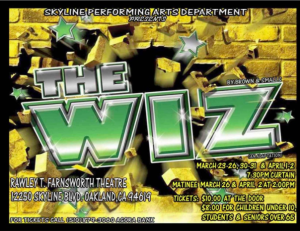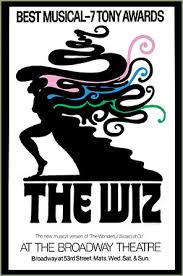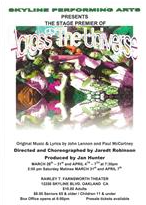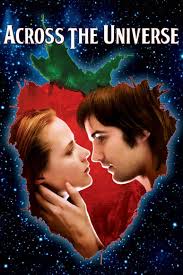This summer, when an attorney for actor James Franco sent New York’s People’s Improv Theatre a cease and desist letter regarding the venue’s planned presentation of the play James Franco and Me, PIT’s response was to cancel the booking. At the time, Kevin Broccoli, author and performer of JF and Me had no legal representation, and so the stories that emerged were that Franco had successfully shut down the production, as highlighted in numerous media outlets, including The New York Times and Rolling Stone.
Among the organizations that stepped in to assist Broccoli were the Arts Integrity Initiative and the Dramatists Legal Defense Fund, and in August, DLDF secured the pro bono services of the law firm Davis Wright Tremaine to represent Broccoli in an effort to insure his play could be seen. Yesterday, DWT responded in writing to Thomas Collier, the attorney at Sloane, Offer, Weber and Stern, who had sent the original cease and desist, asserting that it was without foundation and that Broccoli may present the play and companies may produce it under the protections offered by the First Amendment.
In a statement to Arts Integrity, Broccoli said, “I’m truly amazed at the amount of support my play has received since July when this story broke. I’m very grateful to Davis Wright Tremaine, especially Nicolas Jampol and Kathleen Cullinan, who have been working tirelessly, and to Dramatists Legal Defense, who helped connect me with them. Right now it appears that there’s an opportunity to do the play at several theaters across the county, including New York, and that’s really been my goal from the beginning.”
Jampol’s letter to Collier asks for a response within two weeks. The full text, with all legal citations and footnotes, appears below. It makes for fascinating reading and important information for playwrights.
* * *
We represent playwright Kevin Broccoli in connection with your client James Franco’s attempt to pressure theatrical venues into cancelling performances of Mr. Broccoli’s play James Franco and Me (the “Play”). In particular, we write in response to your July 7, 2017 cease-and- desist letter to the People’s Improv Theater, which resulted in the cancellation of several performances of the Play.
For the reasons explained below, we are confident that your client does not have any valid claim in connection with the Play. Contrary to the assertions in your letter, the First Amendment provides playwrights and other creators of expressive works – including both your client and Mr. Broccoli – with robust protection against the claims you threatened. Put simply, Mr. Broccoli does not need Mr. Franco’s permission to perform the Play, and will perform the Play as he desires. Mr. Broccoli also reserves the right to take legal action if your client continues to interfere with his contractual relationships with theatrical venues.
The Play
In the Play, a character named Kevin – which is based upon, and typically played by, Mr. Broccoli – sits in a hospital waiting room while his father is dying. The “James Franco” character stays with Kevin during the agony and tedium of awaiting a loved one’s fate in a lonely and impersonal waiting room. Their wide-ranging discussion tackles numerous topics like art, passion, sexual identity, and death, while engaging in a critical exploration of Mr. Franco’s films and television projects, including 127 Hours, Spring Breakers, Pineapple Express, Rise of the Planet of the Apes, General Hospital, Spiderman, Oz the Great and Powerful, and This Is the End, among others.
In addition to exploring Mr. Franco’s works, the Play parodies the public perception of Mr. Franco as a passionate, eccentric actor and artist who fully invests himself in his work. In one scene, for example, the “James Franco” character describes how he emotionally cut off his arm in preparation for his role as Aron Ralston in 127 Hours. In other scenes, the character vehemently disclaims any interest in money, highlighting Mr. Franco’s perception as someone who is not simply interested in pursuing projects for maximum financial gain – he believes in the art, and strives for something more than wealth creation.
Apart from examining Mr. Franco’s career and public perception, the Play also uses the “James Franco” character as a vehicle to explore Mr. Broccoli’s own feelings about life, death, his career, and his relationship with his father against the looming sense of mortality in the hospital waiting room. As one review explained, “this play becomes a kind of meta commentary on life, celebrity, loss, failure and friendship.”1
While not relevant to whether Mr. Franco could establish a valid claim against Mr. Broccoli in connection with the Play, the fact is that Mr. Broccoli is a long-time admirer of Mr. Franco and his work, and the portrayal is overwhelmingly positive. The Play specifically refers to Mr. Franco as “one of the most spontaneous and unique performers of his generation,” and explains that if Mr. Franco “stands for anything, it’s artistic simplicity.”
Mr. Franco Has No Viable Right-of-Publicity Claim
The First Amendment protects Mr. Broccoli from any right-of-publicity or misappropriation claim in connection with the “James Franco” character in the Play. Under well-established law, celebrities simply do not enjoy absolute control over the use of their name and likeness, particularly in an expressive context, such as a play.2 Mr. Franco has benefited from this principle in numerous of his works with characters that were based on, or inspired by, real people and events.
In Sarver v. Chartier, 813 F.3d 891, 896 (9th Cir. 2016), for example, an Army sergeant brought right-of-publicity claims against the producers of the film The Hurt Locker, which featured a fictional character that the plaintiff contended was based on him. In affirming the dismissal of the claims, the court explained that “The Hurt Locker is speech that is fully protected by the First Amendment, which safeguards the storytellers and artists who take the raw materials of life – including the stories of real individuals, ordinary or extraordinary – and transform them into art, be it articles, books, movies, or plays.” Id. at 905. Almost four decades earlier, in Guglielmi v. Spelling-Goldberg Productions, 25 Cal. 3d 860, 862 (1979), Rudolph Valentino’s nephew sued over a television movie titled Legend of Valentino: A Romantic Fiction, a fictionalized version of his uncle’s life. In rejecting the claim, Chief Justice Bird wrote for the majority of the court in a now-widely-cited concurrence3 explaining that the First Amendment protected the film against plaintiff’s cause of action for misappropriation of Valentino’s name and likeness:
Contemporary events, symbols and people are regularly used in fictional works. Fiction writers may be able to more persuasively, or more accurately, express themselves by weaving into the tale persons or events familiar to their readers. The choice is theirs. No author should be forced into creating mythological worlds or characters wholly divorced from reality. The right of publicity derived from public prominence does not confer a shield to ward off caricature, parody and satire. Rather, prominence invites creative comment. Surely, the range of free expression would be meaningfully reduced if prominent persons in the present and recent past were forbidden topics for the imaginations of authors of fiction. Id. at 869.4
Without these critical protections, content creators would be required to obtain approval from any real person – or such person’s estate – depicted in a television series, motion picture, or theatrical production, which would allow them to veto controversial or unflattering portrayals. This would place a significant restriction on the marketplace of ideas and would have prevented the production of acclaimed films such as Spotlight, The Social Network, and Selma. As mentioned above, Mr. Franco himself is no stranger to depicting real individuals, including in Milk, Lovelace, and Spring Breakers, among many others.
Mr. Broccoli uses the “James Franco” character to comment on Mr. Franco’s career and public perception, while using it as a vehicle to explore Mr. Broccoli’s feelings about his own life and work, among other topics. In other words, in addition to dealing with a matter in the public interest – Mr. Franco and his career – the Play uses the character to enable Mr. Broccoli to “more persuasively, or more accurately, express [himself].” Guglielmi, 24 Cal. 3d at 869. See also Comedy III Productions, 25 Cal. 4th at 397 (explaining that “because celebrities take on personal meanings to many individuals in the society, the creative appropriation of celebrity images can be an important avenue of individual expression”). As a result, the Play enjoys broad protection under the First Amendment and against any potential right-of-publicity claim that Mr. Franco might assert.5
Mr. Franco Has No Viable Trademark-Infringement Claim
The Lanham Act and state trademark law do not exist to imbue trademark owners and celebrities with the unrestricted power to prevent the unauthorized use of their marks or names in expressive works. Instead, trademark law is “is intended to protect the ability of consumers to distinguish among competing producers, not to prevent all unauthorized uses” of a mark. Utah Lighthouse Ministry v. Found. for Apologetic Info., 527 F.3d 1045, 1052 (10th Cir. 2008). Based on the Play, no reasonable viewer would be confused into thinking that Mr. Franco had sponsored or approved the Play – in fact, the Play makes clear that the “James Franco” character is a fictionalized version of Mr. Franco, and there is absolutely nothing in the Play that suggests or implies that Mr. Franco himself had any involvement in the Play. The implausibility of consumer confusion would bar any trademark-infringement claim here.
Even if Mr. Franco could somehow establish the elements of a Lanham Act claim, it would still fail because the Play is an expressive work entitled to full First Amendment protection. When a Lanham Act claim targets the unauthorized use of a mark in an expressive work, the traditional likelihood-of-confusion test does not apply because it “fails to account for the full weight of the public’s interest in free expression.” Mattel v. MCA Records, 296 F.3d 894, 900 (9th Cir. 2002). Instead, such claims must pass the Rogers test, which bars any Lanham Act claim arising from an expressive work unless the use of the mark “has no artistic relevance to the underlying work whatsoever, or, if it has some artistic relevance, unless the title explicitly misleads as to the source or the content of the work.” Rogers v. Grimaldi, 875 F.2d 994, 999 (2d Cir. 1989). The Rogers test is highly protective of expression, and has since become the constitutional threshold for Lanham Act claims arising from the unauthorized use of marks within expressive works.6
The first prong of the Rogers test is satisfied if the alleged mark as any artistic relevance to the underlying work. See Rogers, 875 F.2d at 999. Courts have interpreted this requirement to mean that “the level of artistic relevance of the trademark or other identifying material to the work merely must be above zero.” Brown v. Electronic Arts, Inc., 724 F.3d 1235, 1243 (9th Cir. 2013) (brackets omitted). The second prong of the Rogers test is satisfied unless the defendant’s work makes an “overt claim” or “explicit indication” that the plaintiff endorsed or was directly involved with the work. Rogers, 875 F.2d at 1001 (“The title ‘Ginger and Fred’ contains no explicit indication that Rogers endorsed the film or had a role in producing it”). This requirement of an “overt claim” applies even where consumers mistakenly believe there is some connection between the mark owner and the expressive work. See, e.g., ETW, 332 F.3d at 937 n.19 (finding that a painting of Tiger Woods did not expressly mislead consumers despite survey evidence that sixty-two percent of respondents believed the golfer had “an affiliation or connection” with the painting “or that he has given his approval or has sponsored it”).7
Because the Play is an expressive work entitled to full First Amendment protection, the Rogers test would apply to any trademark claim Mr. Franco might bring. It is beyond dispute that Mr. Franco’s name is artistically relevant to a play that examines his career and public persona. Moreover, the Play does not make any explicit claim that Mr. Franco endorsed or was affiliated with the Play. To the contrary, Mr. Broccoli made clear in press interviews that the “James Franco” role would be played by different actors – not Mr. Franco8 – and never made any statement or suggestion that Mr. Franco sponsored or was otherwise involved with the Play. Accordingly, because the Rogers test is easily satisfied, the First Amendment bars any trademark-infringement claim by Mr. Franco.9
Mr. Franco Must Cease Interfering with the Exhibition of the Play
We request that Mr. Franco stop interfering with Mr. Broccoli’s right to exhibit the Play, and Mr. Broccoli expressly reserves his right to pursue a claim for such interference. Despite the fact that he can rightfully exhibit the Play without Mr. Franco’s permission, Mr. Broccoli is still an admirer of Mr. Franco, and is willing to engage in dialogue with him or his representatives regarding any specific objections he has to the Play or whether any particular disclaimer would alleviate Mr. Franco’s concerns. Like Mr. Franco, Mr. Broccoli is dedicated to his artistic craft, and despite his legal right to exhibit the Play without Mr. Franco’s permission, he would prefer to focus his time and energy on the Play, and not this dispute.
Footnotes
2 As one court explained in affirming the dismissal of a right-of-publicity claim arising from a film, “[t]he industry custom of obtaining ‘clearance’ establishes nothing, other than the unfortunate reality that many filmmakers may deem it wise to pay a small sum up front for a written consent to avoid later having to spend a small fortune to defend unmeritorious lawsuits such as this one.” Polydoros v. Twentieth Century Fox, 67 Cal. App. 4th 318, 326 (1997).
3 See Comedy III Productions v. Gary Saderup, 25 Cal. 4th 387, 396 n.7 (2001) (recognizing that Chief Justice Bird’s concurrence “commanded the support of the majority of the court”).
4 Chief Justice Bird also explained that it would be “illogical” if the First Amendment allowed the defendants to exhibit the film, but prohibit them from using Valentino’s name in advertising for the film. Id. at 873. See also Polydoros v. Twentieth Century Fox Film Corp., 67 Cal. App. 4th 318, 325 (1997) (holding that the use of the plaintiff’s name and likeness in a film was not an actionable violation of the right of publicity, and thus “the use of his identity in advertisements for the film is similarly not actionable”).
5 The transformative-use defense would provide another layer of constitutional protection against a right-of-publicity claim because Mr. Franco’s likeness is “one of the ‘raw materials’ from which an original work is synthesized,” and his “likeness is so transformed that it has become primarily the defendant’s own expression.” See Winter v. DC Comics, 30 Cal. 4th 881, 888 (2003).
6 See, e.g., Cliffs Notes v. Bantam Doubleday Dell, 886 F.2d 490, 495 (2d Cir. 1989) (holding that “the Rogers balancing approach is generally applicable to Lanham Act claims against works of artistic expression”); ETW Corp. v. Jireh Pub., Inc., 332 F.3d 915, 928 n.11 (6th Cir. 2003) (explaining that the Rogers test is “generally applicable to all cases involving literary or artistic works where the defendant has articulated a colorable claim that the use of a celebrity’s identity is protected by the First Amendment”); E.S.S. Entm’t 2000 v. Rock Star Videos, 547 F.3d 1095, 1099 (9th Cir. 2008) (“Although [the Rogers test] traditionally applies to uses of a trademark in the title of an artistic work, there is no principled reason why it ought not also apply to the use of a trademark in the body of the work.”); Univ. of Alabama v. New Life Art, 683 F.3d 1266, 1278 (11th Circ. 2012) (expressing “no hesitation in joining our sister courts by holding that we should construe the Lanham Act narrowly when deciding whether an artistically expressive work infringes a trademark,” and applying Rogers to “paintings, prints, and calendars”).
7 Similarly, the Rogers court found that the defendants did not expressly mislead despite evidence that “some members of the public would draw the incorrect inference that Rogers had some involvement with the film.” 875 F.2d at 1001. The court explained that any “risk of misunderstanding, not engendered by any overt claim in the title, is so outweighed by the interests in artistic expression as to preclude application of the Lanham Act.” Id.
9 Any unfair-competition claim would fail for the same reasons as a right-of-publicity or trademark-infringement claim. See, e.g., Kirby v. Sega of America, 144 Cal. App. 4th 47, 61-62 (2006) (where First Amendment barred plaintiff’s misappropriation and Lanham Act claims, it also barred her unfair-competition claim).







